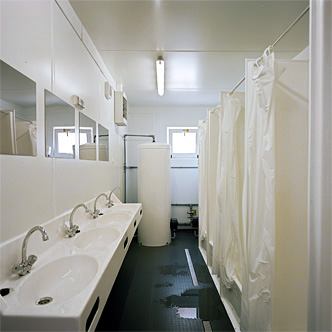supported by Strabag SE | 2010-2013 | a cooperation with Paul Horn
Das vorliegende Fotoprojekt beschäftigt sich mit Großbaustellen in Europa.
Häufig wird in der Architekturfotografie dem Architekturmodell und dem fertiggestellten Baukörper viel Raum gewidmet. Der eigentliche
Realisierungsprozess, d.h. die Bauphase mit ihren komplex organisierten Arbeitsabläufen, wird aber meist vernachlässigt und selten genauer dokumentiert. Das vorliegende Projekt widmet sich diesem Zeitabschnitt.
Neben Baustellenaufnahmen widmet sich eine zweite Fotoserie des Projektes der Wohnsituation des Baustellenpersonals, die in sogenannten Wohncamps untergebracht sind. Dieses besteht in der Regel aus gekoppelten standardisierten 20-Fuß-Containern mit den Innenmaßen 2,40 x 6 Meter pro Einheit. In Ihnen wohnen temporär jeweils zwei Arbeiter pro Einheit. Die Arbeiter versuchen durch die individuelle Gestaltung ihrer privaten Innenräume der anonymen Containerästhetik eine persönliche Note zu verleihen.
Das Projekt zeigt verschiedene Aspekte einer von Rationalität und Funktionalität geprägten Männerwelt, die durch die Austauschbarkeit des Individuums, die kolossalen Dimensionen der Maschinen und der gelblichen Baustellenbeleuchtung oft eine Stimmung von Endzeit und Leere vermittelt.
‚Glück Auf und Vortrieb ohne Unfall‘ /‚Good Luck‘





This photography project explores major construction sites in Europe.
Architecture photography often devotes a lot of space to the architectural model and the finished building. By contrast, the actual process of its realization—the construction phase with its complex sequence of different routines and processes—is generally neglected, and detailed documentation is rare. The present project studies this phase.
In addition to the construction site shots, a second series of photographs included in the project looks at how the construction site staff live. They are housed in so-called work camps, which usually consist of interlocking standardized 20-foot containers; the interior dimensions are 7 ft 10 by 19 ft per unit. They serve as temporary homes for two workers per unit, who decorate their private rooms with individual elements in an attempt to add a personal note to the anonymous aesthetic of the container.
The project illustrates various aspects of a man’s world defined by rationality and utility; with the exchangeability of the individual, the colossal dimensions of the machinery, and the yellow tinge of the construction site illumination, it often conveys a sense of desolation: the end, it seems here, is near.







Wohncamp /Work Camps




<< back